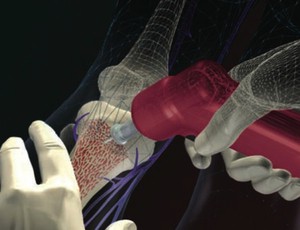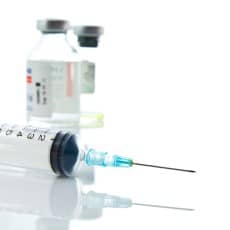Temperature-responsive intravenous needle

“In mice, the needles had similar fluid-delivery performance and caused substantially less inflammation than commercial devices for intravenous access of similar size. We also show that an intravenous needle integrated with a thin-film temperature sensor can monitor core body temperature in mice and detect fluid leakage in porcine tissue ex vivo” Agno et al (2023).
Administration of IV fluids and medicines in children

“n this article the author describes various types of venous access devices that are commonly seen in practice and details the preparation, checking and administration of IV fluids and medicines, including some complications that may arise” Rosengarten (2023).
Intraosseous or intravenous epinephrine administration

“These findings support the inclusion of intraosseous access as a route for epinephrine administration in current guidelines” Roberts et al (2021).
Pain associated with continuous intravenous bumetanide infusion

“For all patients, pain symptoms resolved within 24 to 48 hours after discontinuation of bumetanide infusion with no significant electrolyte abnormalities” Herges et al (2021).
How accurate are IV antibiotic administration times

“Overall, there were discrepancies between actual and documented antimicrobial infusion administration times” Roydhouse et al (2021).
Intramuscular glucagon to prevent IV glucose infusion in early neonatal hypoglycemia

“After IM glucagon, 24 out of 49 infants that met AAP criteria for immediate IV glucose (49%) ended up not requiring any additional intervention” Kasirer et al (2021).
International consensus on cardiopulmonary resuscitation – Full Text

“Systematic reviews addressed higher-priority topics, and included double-sequential defibrillation, intravenous versus intraosseous route for drug administration during cardiac arrest” Berg et al (2020).
Oncology infusion center workflow improves following IV push conversion

“Successful conversion to aprepitant, and specifically to a 2-min IV push, provides time, cost, and resource savings, improves operational efficiency, and avoids the negative impact of potential future IV fluid shortages” Burns et al (2020).
Intravenous fluid therapy protocol in the perioperative and critical care setting – Full Text

“Intravenous fluid administration should be considered as any other pharmacological prescription. There are three main indications: resuscitation, replacement, and maintenance” Malbrain et al (2020).
Study examines long-term stability of analgesic infusions in glass bottles

“Infusion of paracetamol, alizapride, ketorolac and tramadol remains stable for 7 days in glass bottles at 5°C ± 3 °C and could be prepared in advance with these storage conditions” Colsoul et al (2020).
IV versus intraosseous adrenaline administration in out-of-hospital cardiac arrest

“The 2018 Advanced Cardiac Life Support (ACLS) algorithm gives the option of either intravenous (IV) or intraosseous (IO) routes for adrenaline administration during cardiac arrest” Zhang et al (2020).
Intraosseous versus intravenous drug administration in patients with out-of-hospital cardiac arrest

“To compare the effectiveness of the intravenous (IV) and intraosseous (IO) routes for drug administration in adults with a cardiac arrest enrolled in the Pre-Hospital Assessment of the Role of Adrenaline” Nolan et al (2020).
Principles and aims of intravenous fluid therapy

“Nurses will often encounter patients with a disrupted fluid balance, particularly in critical care. They will be involved in assessing patients’ fluid status and administering and monitoring therapy” Guest (2020).
Safety of antiemetic prophylaxis infusion in patients with cancer

“The neurokinin 1 receptor antagonist HTX-019 (CINVANTI® ) was approved for preventing chemotherapy-induced nausea and vomiting” Perry et al (2020).
Survival after intravenous versus intraosseous Amiodarone

Survival to hospital admission also increased significantly when drugs were given IV but not IO, and favored improved neurological outcome at discharge” Daya et al (2020). Abstract: Background: Antiarrhythmic drugs have not proven to significantly improve overall survival after out-of-hospital cardiac arrest (OHCA) from shock-refractory ventricular fibrillation/pulseless ventricular tachycardia (VF/VT). How this might be influenced […]
Safety of intravenous push thiamine administration

The objective of this analysis was to evaluate the incidence of anaphylaxis and IV site reactions associated with IV push thiamine” McLaughlin et al (2020). Abstract: OBJECTIVES: Intravenous (IV) thiamine, administered using both diluted solution for infusion and undiluted solution for IV push, is used to correct low levels of thiamine. Although thiamine has a […]
Prolonged versus intermittent infusion of antibiotics

We conducted a meta-analysis to summarize all published randomized controlled trials (RCTs), prospective and retrospective observational studies to determine whether prolonged infusion, compared to intermittent infusion, is correlated with lower mortality and better clinical outcome” Luo et al (2019). Abstract: BACKGROUND: Acute and severe infections are an absolute indication for the use of intravenous broad-spectrum […]
Evaluation of incompatible intravenous infusion administration

We aimed to evaluate and quantify incompatible coadministrations of continuous intravenous medication in the daily clinical practice of a PICU/NICU” Häni et al (2019). Abstract: OBJECTIVES: We aimed to evaluate and quantify incompatible coadministrations of continuous intravenous medication in the daily clinical practice of a PICU/NICU. METHODS: We conducted a retrospective, observational study in the […]
Intravenous versus subcutaneous trastuzumab administration

Since 2005, when the first patients outside of a clinical trial were treated with trastuzumab at The Christie NHS Foundation Trust, a nurse-led service has been developed to facilitate and support a safe treatment pathway for patients” Mitchell and Morrissey (2019). Abstract: Since 2005, when the first patients outside of a clinical trial were treated […]
Intravenous versus intraosseous access in prehospital cardiac arrest

The aim of this study was to evaluate the effectiveness of IV access versus IO access in terms of return of spontaneous circulation (ROSC) for patients suffering from cardiac arrest” Nguyen et al (2019). Abstract: OBJECTIVE: The prevailing standard of care in prehospital emergency medical services (EMS) is that either intravenous (IV) or intraosseous (IO) […]
Prescribing intravenous fluid therapy in acutely ill patients

Prescribing intravenous fluids is a complex process involving a decision on the type, composition, dose, rate and possible toxicity of the particular solution” Matějovič et al (2019). Abstract: Intravenous fluid therapy is the most frequent therapeutic intervention in acutely hospitalized patients. They are administered in order to resuscitate the circulation in hypovolemia-associated shock states, to […]
Article describes controlled infusion of intravenous cardiac drugs

The objective of the study is to develop an automatic drug infusion control system during cardiovascular surgery” Sowparnika et al (2019). Abstract: OBJECTIVES: The objective of the study is to develop an automatic drug infusion control system during cardiovascular surgery. MATERIALS AND METHODS: Based on the clinical drug dosage analysis, the modeling of cardiovascular system […]
Adaptive smith predictor controller for total intravenous anesthesia automation

The main objective of this proposal is to design robust automated control system that work efficiently in most of the patients with smooth BIS and minimum variations of propofol during surgery to avoid adverse post reactions and instability of anesthetic parameters” Patel et al (2018). Abstract: Anesthetic agent propofol needs to be administered at an […]
Economic impact of OPAT versus oral antibiotic therapy

Our objective was to compare economic burden between OPAT and oral therapy, accounting for direct and indirect costs and caregiver quality of life (QoL)” Krah et al (2019). Abstract: BACKGROUND: There is increasing evidence that outpatient parenteral antimicrobial therapy (OPAT) is overused for children and that outcomes with oral therapy are equivalent. Our objective was […]
Pharmacokinetic effects of endotracheal, intraosseous, and intravenous epinephrine

This study compared the maximum concentration (Cmax), time to maximum concentration (Tmax), plasma concentration over time, return of spontaneous circulation (ROSC), time to ROSC, and odds of ROSC of epinephrine administered by the endotracheal (ETT), intraosseous (IO), and intravenous (IV) routes in a swine TCA model” Burgert et al (2019). Abstract: Introduction: Limited prospective data […]
Home self-administration of intravenous antibiotics

The key behavioural determinants emerging as encouraging patients to self-administer intravenous antibiotics were the perceptions of being sufficiently knowledgeable, skilful and competent and that self-administration afforded the potential to work while administering treatment” Tonna et al (2019). Abstract: OBJECTIVES: This study aimed to use a theoretical approach to understand the determinants of behaviour in patients […]
Intranasal route is comparable to intravenous administration

Medications administered by the intranasal route have efficacy comparable to intravenous administration and typically have superior efficacy to subcutaneous or intramuscular routes” Tucker et al (2018). Abstract: Intranasal drug administration is a less invasive method of drug delivery that is easily accessible for adult and pediatric patients. Medications administered by the intranasal route have efficacy […]
Oral versus intravenous antibiotics for bone and joint infection

Oral antibiotic therapy was noninferior to intravenous antibiotic therapy when used during the first 6 weeks for complex orthopedic infection, as assessed by treatment failure at 1 year” Li et al (2019). Abstract: BACKGROUND: The management of complex orthopedic infections usually includes a prolonged course of intravenous antibiotic agents. We investigated whether oral antibiotic therapy […]
Intravenous compared with oral iron for the treatment of iron-deficiency anemia in pregnancy

To assess the effect of intravenous versus oral iron on hematologic indices and clinical outcomes for iron-deficiency anemia (IDA) in pregnancy” Lewkowitz et al (2019). Abstract: Objective: To assess the effect of intravenous versus oral iron on hematologic indices and clinical outcomes for iron-deficiency anemia (IDA) in pregnancy. Study design: Searches in Ovid Medline, Embase, […]
Overview of total intravenous anaesthesia

Total intravenous anaesthesia (TIVA) is a technique to induce and maintain general anaesthesia exclusively with intravenous anaesthetic agents, thereby avoiding the use of inhalational agents” McGrenaghan and Wilson (2019). Abstract: Total intravenous anaesthesia (TIVA) is a technique to induce and maintain general anaesthesia exclusively with intravenous anaesthetic agents, thereby avoiding the use of inhalational agents. […]

